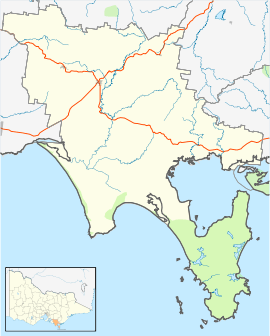Koonwarra, Victoria
Koonwarra is a town in the South Gippsland region of Victoria, Australia. At the 2016 census, Koonwarra had a population of 404.[1] The town straddles the South Gippsland Highway.[2] Located around 128 km southeast of Melbourne, the town was served by rail from the 1890s until 1991 with the closing of the rail line to Barry Beach.[3]
| Koonwarra Victoria | |
|---|---|
 Koonwarra Location in South Gippsland Shire | |
| Coordinates | 38°32′50″S 145°56′49″E |
| Population | 404 (2016 census)[1] |
| Postcode(s) | 3954 |
| LGA(s) | South Gippsland Shire |
| State electorate(s) | Gippsland South |
| Federal Division(s) | Monash |
Koonwarra fossil bed
The Koonwarra fossil bed was found by accident in 1961 during roadworks to realign a segment of the South Gippsland Highway. Dating from the early Cretaceous 115 million years ago, they are composed of mudstone sediment thought to have been laid down in a freshwater (possibly cool-climate subalpine) lake.The site is an important element of Australia's fossil record, with plants, insects (including mayflies, dragonflies, cockroaches, beetles, fleas, flies and wasps), spiders, crustaceans and fish recovered.[4] Among them is the unusual finding of a fossil horseshoe crab described as Victalimulus mcqueeni.[5] Small segments of a leafy twig have been recovered that were thought to be one of the oldest angiosperms (flowering plants) discovered; more recent examination reports anatomy more typical of a gnetophyte, a group of plants for which there is a scant fossil record.[6] A fossil member of the Ginkgo family, Ginkgoites australis, has also been recovered.[7]
Six well-preserved feathers have been recovered, indicating more complete remains of feathered dinosaurs might be found, however the site has been little-excavated, extensive removal of overlying rock has to take place before further excavation.[8]
References
- "2016 Census QuickStats Koonwarra". Australian Bureau of Statistics. Retrieved 26 April 2019.
- Wheeler, Donna (2008). Discover Melbourne & Victoria. Lonely Planet. p. 278. ISBN 9781741048629.
- Prom Country Regional Tourism Inc. (2012). "Koonwarra". Visit Prom Country. South Gippsland Shire Council. Retrieved 22 November 2014.
- "Koonwarra fossil bed". Treasures: Museum Victoria Celebrates 150 Years. Museum Victoria. 2004. Retrieved 22 November 2014.
- Riek, E.F.; Gill, E.D. (1971). "A new xiphosuran genus from Lower Cretaceous freshwater sediments at Koonwarra, Victoria, Australia" (PDF). Palaeontology. 14 (2): 206–10. Archived from the original (PDF) on 29 November 2014. Retrieved 21 November 2014.
- V.A. Krassilov; D.L. Dilcher; J.G. Douglas (1998). "New ephedroid plant from the Lower Cretaceous Koonwarra Fossil Bed, Victoria, Australia" (PDF). Alcheringa: An Australasian Journal of Palaeontology. 22 (2): 123–33. doi:10.1080/03115519808619195.
- Jones, Robert (16 July 2009). "Fossil: Ginkgo Tree: Ginkgoites australis". Nature Culture Discover. Australian Museum. Retrieved 21 November 2014.
- Piper, Kylie (11 November 2010). "Discovering the dinosaurs Down Under". Australian Geographic. ninemsn. Retrieved 22 November 2014.